Cell-cycle checkpoint genes
a cell cycle and checkpoint technology, applied in the field of cell cycle checkpoint genes, can solve the problems of lethal damage and disruption of several checkpoints required for an appropriate response to ionising radiation
- Summary
- Abstract
- Description
- Claims
- Application Information
AI Technical Summary
Benefits of technology
Problems solved by technology
Method used
Image
Examples
example 1
[0138] The rad3 gene of S. pombe is one of six genes absolutely required for the DNA structure checkpoints in S. pombe (Al-Khodairy and Carr. 1992; Al-Khodairy et al. 1994). A sequence representing part of the rad3 gene was reported by Seaton et al. (1992). In attempting to clarify the intron / exon structure of this gene we identified sequencing anomalies at both the 5′ and 3′ ends. We have sequenced the complete gene (see Experimental Procedures) and find that rad3 is capable of encoding a product of 2386 amino acids. The C-terminal region contains the consensus sequences typical of a sub-class of kinases known as lipid kinases, the founder member of which is the p110 catalytic subunit of P13 kinase (Hiles et al. 1992).
[0139] A truncated rad3 clone lacking the amino terminus and the kinase region has been reported to complement the rad3::pR3H1.0 gene disruption mutant of rad3 (Jimenez er al. 1992). This disruption mutant does not remove the potential kinase domain. To clarify the r...
PUM
| Property | Measurement | Unit |
|---|---|---|
| cell size | aaaaa | aaaaa |
| cell size | aaaaa | aaaaa |
| time | aaaaa | aaaaa |
Abstract
Description
Claims
Application Information
 Login to View More
Login to View More - R&D
- Intellectual Property
- Life Sciences
- Materials
- Tech Scout
- Unparalleled Data Quality
- Higher Quality Content
- 60% Fewer Hallucinations
Browse by: Latest US Patents, China's latest patents, Technical Efficacy Thesaurus, Application Domain, Technology Topic, Popular Technical Reports.
© 2025 PatSnap. All rights reserved.Legal|Privacy policy|Modern Slavery Act Transparency Statement|Sitemap|About US| Contact US: help@patsnap.com

